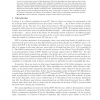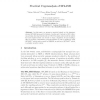88
Voted
CRYPTO
2007
Springer
15 years 7 months ago
2007
Springer
The common random string model introduced by Blum, Feldman and Micali permits the construction of cryptographic protocols that are provably impossible to realize in the standard m...
110
Voted
CRYPTO
2007
Springer
15 years 7 months ago
2007
Springer
Abstract. We study the natural problem of secure n-party computation (in the passive, computationally unbounded attack model) of the n-product function fG(x1, . . . , xn) = x1 · x...
CRYPTO
2007
Springer
15 years 7 months ago
2007
Springer
We derive a new entropic quantum uncertainty relation involving min-entropy. The relation is tight and can be applied in various quantum-cryptographic settings. Protocols for quant...
70
Voted
CRYPTO
2007
Springer
15 years 7 months ago
2007
Springer
86
Voted
CRYPTO
2007
Springer
15 years 7 months ago
2007
Springer
91
Voted
CRYPTO
2007
Springer
15 years 7 months ago
2007
Springer
This work describes a mode of operation, TET, that turns a regular block cipher into a length-preserving enciphering scheme for messages of (almost) arbitrary length. When using a...
91
Voted
CRYPTO
2007
Springer
15 years 7 months ago
2007
Springer
In this paper, we present a practical attack on the signature scheme SFLASH proposed by Patarin, Goubin and Courtois in 2001 following a design they had introduced in 1998. The att...
75
Voted
CRYPTO
2007
Springer
15 years 7 months ago
2007
Springer
CRYPTO
2007
Springer
15 years 7 months ago
2007
Springer
We initiate a complexity-theoretic treatment of hardness amplification for collision-resistant hash functions, namely the transformation of weakly collision-resistant hash functio...
85
Voted
CRYPTO
2007
Springer
15 years 7 months ago
2007
Springer
The economics of information security has recently become a thriving and fast-moving discipline. As distributed systems are assembled from machines belonging to principals with div...






